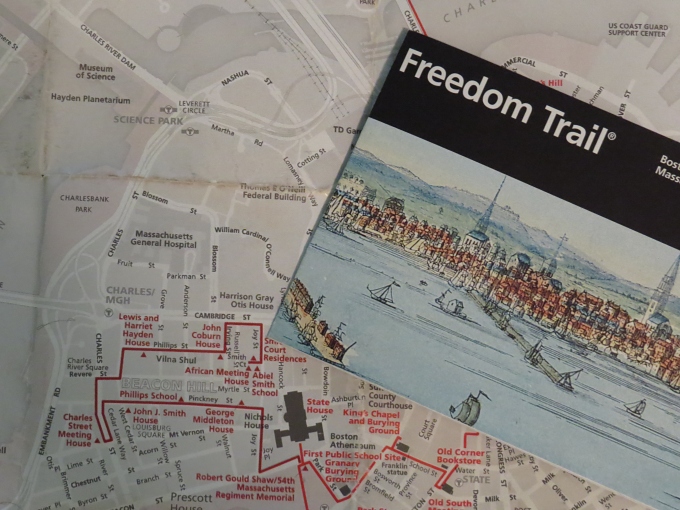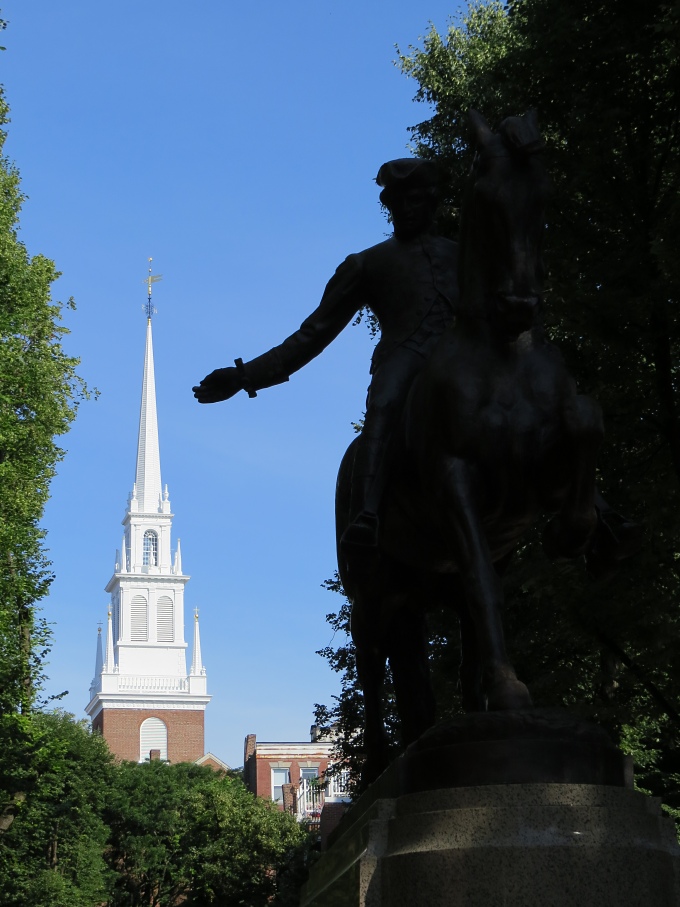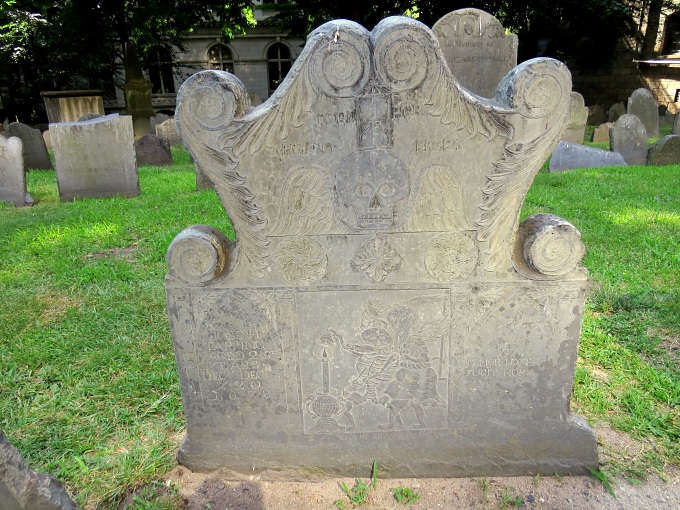Walking Boston's Freedom Trail
/I was born, bred, reared and educated in Massachusetts, yet I'd never walked Boston's famous Freedom Trail. Neither had David, but he had an excuse … he wasn't born here. Like so many people, I always took for granted what was in my own backyard. I aimed to rectify this grievous oversight. Our #1 goal this weekend was to walk every inch of that circuitous, red-bricked/striped trail, tracing Boston and the USA's colonial history; every other activity and sight (though the list was mighty long) was ancillary.
There's lots of information about the Freedom Trail … books galore, guides, pamphlets. You can hire a tour guide, but quite honestly Boston is a walking city and it's easy to get around. The Freedom Trail is only 2-1/2 miles long and the City of Boston conveniently provides a trail map and lots of information on line. We figured we'd start with that and pick up anything else we needed for free at one of the many Visitor's Centers strategically placed around town.
The weather was hot and sultry, 95F (35C) and humid. We slathered on the sunscreen, put on our hats, packed extra water and off we went … at 0730 while it was still moderately cool. The trail actually begins at the Boston Common Visitor's Center in downtown Boston, but we were staying in Charlestown at the end of the trail and within view of the USS Constitution and Bunker Hill. We planned to walk the trail backwards … pretty much in keeping with the way we do most everything, I guess.
First stop, the USS Constitution herself, affectionately known as “Old Ironsides” is the oldest commissioned warship “still afloat”, in the US Navy and in fact, in the world. We questioned the “still afloat” criteria attached to this superlative, pondering the fact that if she wasn't afloat, would she still be commissioned? Built in Boston and launched in 1797, the 44-gun frigate has had a rough life, but was restored in 1995 and now serves as the United States Ship of State, berthed in the old Charlestown Navy Yard and looking splendid. Security to board required a picture ID for adults over 18, but admission is free. We toured her from stem to stern … definitely not Nine of Cups, but a beauty of a ship. The nearby Constitution Museum provided lots of information about the ship as well as US military history … also free entry although a donation is requested.
We trudged up the gentrified streets of Charlestown to the top of Breed's Hill where the Bunker Hill Monument is situated. You'd think it would be on the top of Bunker Hill, but it's not. It was called the Battle OF Bunker Hill which is a misnomer; it should have been the Battle FOR Bunker Hill … possession of the high ground was strategically important here. This battle represented the first real clash between the colonists and the British regulars, aka Red Coats, aka Lobsterbacks. The familiar quotes “Don't shoot till you see the whites of their eyes”(we were low on ammo), “The Redcoats are coming! The Redcoats are coming!”, all familiar to American school children, all emanate from this battle. The obelisk is pretty impressive as is the museum across the street. In theory, you can climb the 294 steps to the top, but it was so stiflingly hot, it was closed. Thank goodness because we would have felt compelled to do it.
We followed the trail across the 113-year-old Charlestown Bridge (which definitely looks its age) into the North End, Boston's oldest residential neighborhood. We wandered through Copp's Hill Burying Ground, one of three burial grounds we would visit along the route. It was in the windows of the nearby church steeple of the Old North Church (Boston's oldest church - 1723) that the prearranged “two if by sea” lantern signal was given to warn the colonist militia that the British regulars were advancing. We visited the austere church. Sometimes, the bell tower and crypts are open to the public, but not when we were there. Behind the church, we strolled through the shady, tree-lined Paul Revere Mall where Paul Revere's ride, made famous by the Longfellow poem, is immortalized forever in bronze.
The North End is known as the Italian section of Boston and though we faithfully followed the red Freedom Trail past Paul Revere's house, heading along Hanover Street, then threading our way down side streets. We couldn't help but take in the sweet aromas of Italian cooking and pastries and formulate our dinner plans. Hunger always trumps history.
On to Quincy Market and Fanueil Hall, old market buildings and meeting places where men like Sam Adams and James Otis, those rabble-rousers, delivered impassioned speeches against injustices (like tea taxes, for instance) placed upon the colonies by King George. Now filled to capacity with overpriced souvenir shops, boutiques and kitschy restaurants, these were too commercial for our tastes and since we'd visited in the past, we gave them a pass. If you've never been inside, however, it'd be worth a stop.
The Old State House (not to be confused with the new/current State House) sits serenely and solidly between skyscrapers. It was on the balcony here that the Declaration of Independence was first read to the colonial Bostonians. It's read each year on the 4th of July from the same balcony. A stone circle marker on the sidewalk nearby marks the site of the Boston Massacre, a misunderstanding between British soldiers and civilians that escalated and was propagandized into a “massacre” to fuel the fires of dissent. It's now a museum, and the cost for admission outweighed our interest at the moment and after a quick look at the gift shop, we moved on.
The gambrel-roofed Old Corner Bookstore, originally an apothecary shop in 1718, became a print shop in the 19th century where authors like Emerson, Longfellow, Holmes (Oliver Wendell not Sherlock),Alcott, Stowe and Hawthorne had their works published. Admission is free. Just down the street, the Old South Meeting House was erected as a Puritan church and was the site of the speech given by Sam Adams that launched the Boston Tea Party and changed the course of history for the United States. Admission fee charged.
Boston born Benjamin Franklin greets you in bronze as he stands regal on the shady lawn of the Old City Hall, originally the site of the Boston Latin School, America's oldest public school. A little trivia … this statue is the first statue of a person ever erected in Boston (1856) and it caused quite a stir at the time.
Around the corner is King's Chapel and Burying Ground. Here we wandered, trying to make out the weather-worn inscriptions on the gravestones. Several dignitaries were buried here, as was Elizabeth Pain, the inspiration for Nathaniel Hawthorne's Scarlet Letter. We were most impressed, however, with the final resting place of Joseph Tapping, just an ordinary shopkeeper, with a very graphic, artfully engraved tombstone. The King's Chapel, an elegant Georgian style church, is best known as being a hangout for the Loyalists aka Tories aka loyal British citizens.
Just down the road, not more than a block away is the Granary Burial Ground and this one is worth some time. First of all, we met a fellow on the steps to the burial ground handing out plastic-bound “guides” to the cemetery and its residents. We thought “what a come-on”, but the guide was free. Jimmy Cole asked that we return the guide when we left and make a small donation, but only if we found the guide helpful. Well, what a treasure trove of information Jimmy provided. We visited the graves of Samuel Adams, Paul Revere, Thomas Paine and even Mother Goose, among others … so much more appreciated because of the details provided by Jimmy. So if you visit, take his guide, give him a few bucks for his efforts and say thanks. With Jimmy's permission, here's a link to his website and guides. He's continually doing upgrades, working on an audio tour and new apps all the time. It's awesome.
Nearing the end of the Freedom Trail, we peeked into the Park Street Church. Though not from the Revolutionary era, the national song “My Country Tis of Thee” (sung to the tune of Britain's “God Save the King” and the US national anthem until 1916) was first sung here in 1831 and many an anti-slavery speech was delivered here as well.
Ah, the end (or the beginning, depending on your perspective) of the trail at the Boston Common, America's oldest public park (1634). Overshadowed by the State House, this was originally a place for gathering, cattle grazing and military exercises. It's now a place for arranging tours, selling souvenirs, lying on the grass, and wading pools that freeze over for skating in the winter.
Everything about Boston shouts history. Every corner, every nook and cranny, every place you turn, there's something to remind us of our heritage. Hope you enjoyed your tour. We highly recommend walking the Freedom Trail. You could do it in a few hours as we did, a day, a couple of days or a week, seeing and learning something new with each step.
Lest you think Boston is only history, however, there's much, much more. Click here for more about Boston as we tick off our Boston Bucket List.














